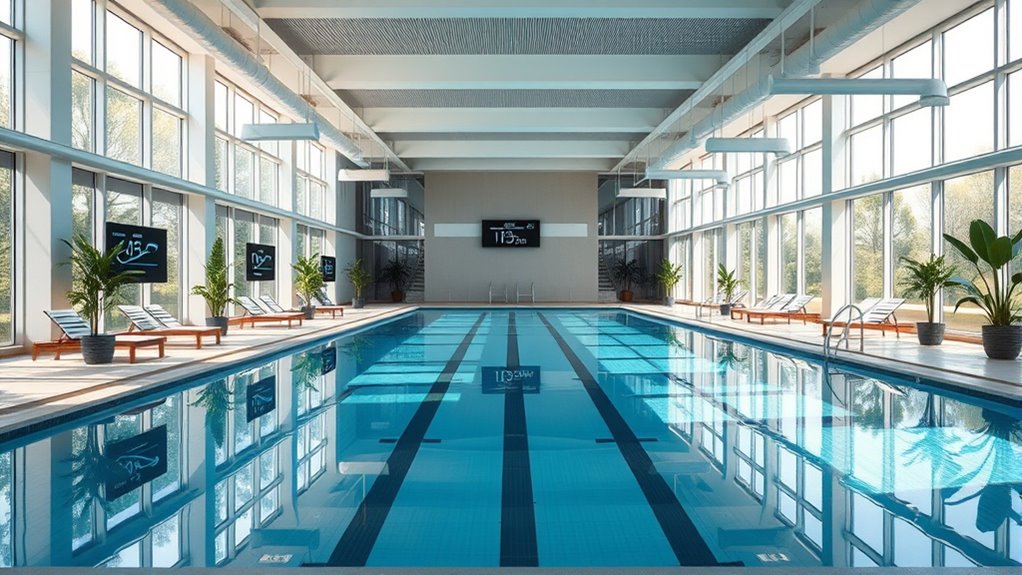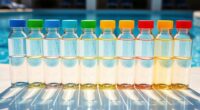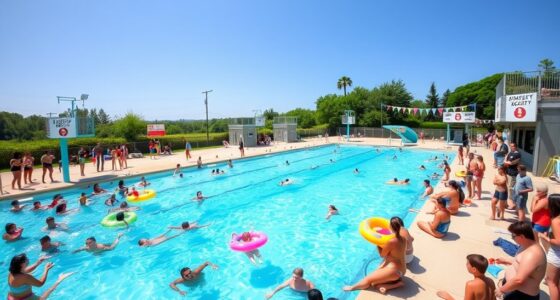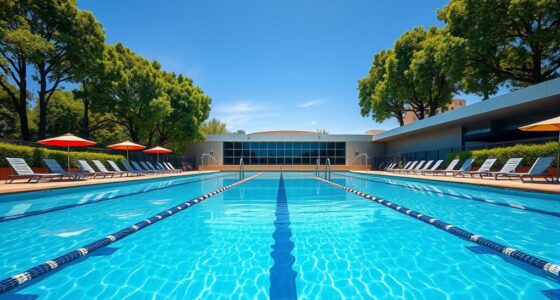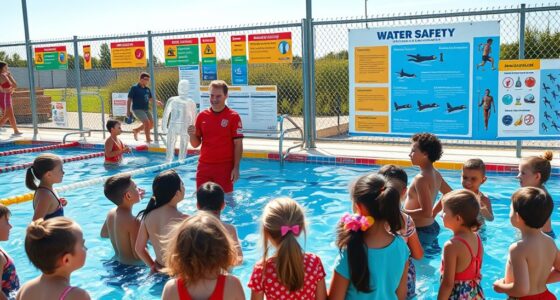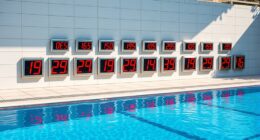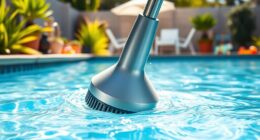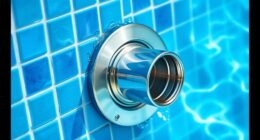To optimize your indoor aquatic facility for year-round use, focus on maintaining water temperature between 78°F and 82°F for comfort and safety. Control humidity levels between 50% and 60% using advanced ventilation and dehumidification. Regularly monitor and adjust these conditions with automated systems to prevent mold, corrosion, and discomfort. Proper insulation and energy-efficient equipment help reduce costs. Keep exploring to discover how balancing these factors guarantees a safe, comfortable, and sustainable environment all year long.
Key Takeaways
- Maintain water temperature between 78°F to 82°F for comfort, safety, and extended use year-round.
- Implement advanced dehumidification systems to control humidity between 50% and 60%, preventing moisture issues.
- Ensure proper insulation and energy-efficient HVAC systems to reduce energy costs and maintain stable indoor conditions.
- Utilize continuous monitoring and automated controls for real-time adjustments of temperature and humidity levels.
- Regularly inspect and maintain building materials and equipment to prevent environmental damage and prolong facility lifespan.
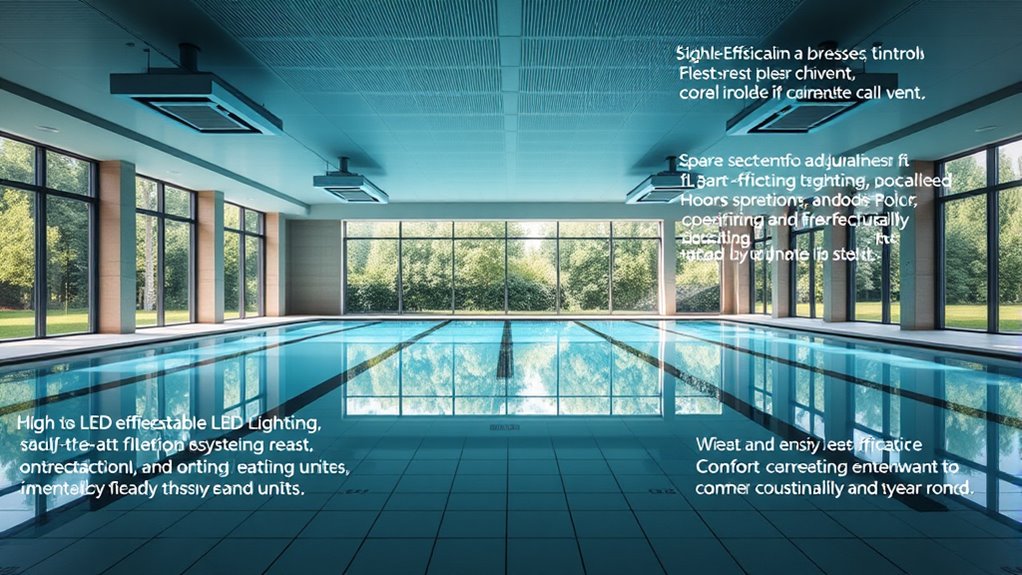
Indoor aquatic facilities offer a reliable solution for year-round swimming and water-based activities, regardless of weather conditions. To guarantee comfort and safety, maintaining ideal water temperature and humidity control is essential. You want the water to be warm enough to encourage extended swimming sessions without feeling too hot, especially during colder months. Typically, water temperatures between 78°F (25.5°C) and 82°F (27.8°C) strike a good balance for recreational swimming, aquatic therapy, and training. Precise temperature regulation helps prevent swimmer discomfort and reduces the risk of illness, making the environment inviting for users of all ages and skill levels.
Maintaining optimal water temperature ensures comfort and safety for swimmers of all ages and skill levels.
Humidity control is just as critical. When you’re inside an aquatic facility, high humidity levels can lead to foggy windows, slippery surfaces, and the growth of mold or bacteria. These issues not only compromise the facility’s appearance but also pose safety hazards and health risks. Proper ventilation systems are necessary to keep humidity at comfortable levels—ideally between 50% and 60%. This range minimizes moisture buildup while ensuring the air remains fresh and breathable. Advanced dehumidification technology is often employed to efficiently remove excess moisture from the air, reducing the need for frequent cleaning and maintenance.
You should also consider how the environment impacts energy consumption. Maintaining water temperature and humidity involves significant energy use, but modern HVAC and dehumidification systems are designed to maximize efficiency. Insulating the building properly helps retain heat, reducing energy costs associated with heating water and air. Additionally, integrating energy-efficient pumps and filtration systems ensures that the water stays clean and at the right temperature without excessive energy expenditure.
Furthermore, controlling humidity and temperature contributes to the longevity of the facility’s infrastructure. Excess moisture can deteriorate building materials, lead to corrosion, and damage equipment. Regular monitoring and adjustments are necessary to keep conditions stable. Automated systems that continuously measure water temperature and humidity levels can alert you to any deviations, allowing quick corrective actions. This proactive approach minimizes downtime and ensures the facility remains operational year-round. Energy-efficient systems play a vital role in reducing operational costs while maintaining optimal conditions for users and infrastructure alike.
Frequently Asked Questions
What Are the Most Energy-Efficient Heating Options for Indoor Pools?
You should consider solar heating and heat pumps for energy-efficient indoor pool heating. Solar heating uses sunlight to warm water, reducing reliance on electricity or gas, while heat pumps extract heat from the air to efficiently maintain desired temperatures. Combining these options can lower energy costs and environmental impact, ensuring year-round comfort. Both methods are sustainable choices that maximize efficiency and minimize operational expenses.
How Can Humidity Levels Be Effectively Controlled in Indoor Aquatic Facilities?
Did you know that improper humidity control can increase energy costs by up to 30%? To effectively control humidity levels, you should use advanced dehumidification techniques like heat pump dehumidifiers or ventilated air systems. Implement moisture control strategies such as proper ventilation, exhaust fans, and humidity sensors. These methods help maintain comfortable, safe environments, reduce mold risk, and improve energy efficiency in your indoor aquatic facility.
What Are the Best Materials for Waterproofing Indoor Pool Construction?
You should choose durable materials like epoxy coatings, PVC membranes, or bentonite clay for pool waterproofing. These materials create reliable moisture barriers and prevent leaks. Using high-quality waterproofing membranes guarantees moisture stays out of surrounding structures, protecting your facility’s integrity. Incorporate these moisture barriers beneath and around the pool area to maintain a dry environment, reduce maintenance costs, and extend the lifespan of your indoor aquatic facility.
How Do Ventilation Systems Impact Indoor Air Quality and Energy Use?
Your ventilation system directly impacts indoor air quality and energy use by guaranteeing proper air exchange and pollutant removal. It helps maintain fresh air, reduces humidity, and minimizes chlorine byproducts, creating a healthier environment. Efficient systems balance adequate ventilation with energy conservation, so you should choose one that maximizes pollutant removal while limiting unnecessary energy consumption. Regular maintenance ensures peak performance, keeping your indoor aquatic facility safe and comfortable year-round.
What Maintenance Practices Ensure Year-Round Safety and Cleanliness?
Maintain meticulous monitoring by regularly inspecting equipment and ensuring chemical balance. Consistent equipment inspections prevent potential problems, while balanced chemicals keep water safe and inviting. Clean filters thoroughly, check for leaks, and calibrate systems to promote pristine, safe conditions year-round. By prioritizing these practices, you protect swimmers, prevent costly repairs, and promote a pristine, protected aquatic environment that’s safe, sound, and sustainable all year long.
Conclusion
So, now you’re all set to turn your indoor aquatic facility into a year-round paradise. Just add a dash of excellent insulation, sprinkle in some energy-efficient tech, and voilà — you’ll have a swimming haven no matter the season. Who knew that with a little clever planning, you can dodge the winter blues and keep those water slides rolling all year? Just remember, the secret to success is pretending you’re a savvy architect, not a weather weathervane!
